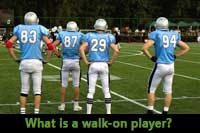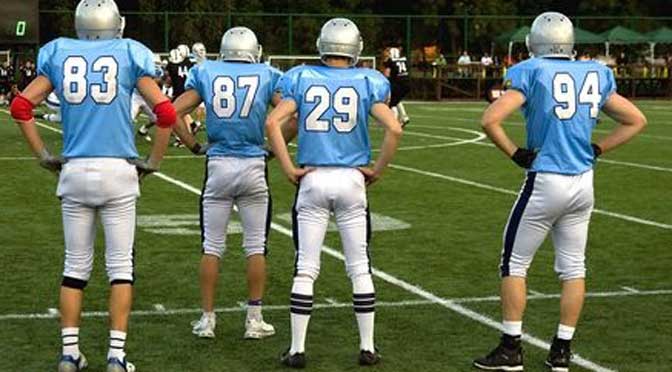 College athletes without a scholarship that play on a team that offers scholarships are generally referred to as “walk-ons.” Over time, the term has evolved such that now some people recognize three types of walk-ons. There are preferred walk-ons, recruited walk-ons, and just plain walk-ons. If you’re going to be a walk-on, “preferred” is definitely the way to go.
College athletes without a scholarship that play on a team that offers scholarships are generally referred to as “walk-ons.” Over time, the term has evolved such that now some people recognize three types of walk-ons. There are preferred walk-ons, recruited walk-ons, and just plain walk-ons. If you’re going to be a walk-on, “preferred” is definitely the way to go.
Learn How to Profile a College
Why the Coach Should Know You Before You Walk-on Campus
The first two terms for walk-ons, preferred walk-ons and recruited walk-ons, have until recently meant the same thing. However, probably only among certain highly ranked revenue sports teams, the terms can indicate two separate types. It will be up to you to decide how the coaches recruiting you are using the terms.
The preferred walk-on has actually been recruited by the coach who has offered the player a spot on the roster. The player isn’t offered any scholarship money as a freshman but there is the possibility in the future.
A recruited walk-on has been recruited by the coach with the understanding that there is the possibility of making the team. The player has in no way been offered a spot on the team.
A plain walk-on player is someone who has decided to try out for the team without the coaches’ support. It’s possible that the coach actually knows the athlete but never decided to pursue him.
What’s the difference? It really depends on the team and the coaches’ attitudes. Preferred walk-ons (and from now on I’m including recruited walk-ons in this category for simplicity’s sake) are often treated no differently than scholarship players. However, depending on the sport, regular walk-on players may be treated as simply living practice dummies.
How do you know if you’re being recruited as a walk-on? Dianne DeNecochea has provides some sample language coaches might use to indicate that they’re recruiting you as a walk-on. It’s worth a read even if you aren’t looking to play volleyball.
If you’re going to walk-on, make sure you establish a relationship with the coach before starting college. Being a stealth walk-on is not a good idea.
Not All Players are Created Equal
It’s hard not to romanticize the opportunity to walk-on to a team. After all, we’re essentially talking about the triumph of the underdog and the media loves playing up such stories. I’m not just talking about Rudy. The NCAA has a page on the 17 of the best walk-ons in college football history and 9 of college baseball’s best walk-ons. The NFL helps with Top 10 active NFL players who were college walk-ons.
But while being a preferred walk-on is the way to go, it’s important for players to understand that the playing field may not be as level as you would like to believe. Consider the volleyball coach who tells the Baylor Lariat that “walk-on athletes are treated the same as athletes on scholarship. During practice, they receive the same workout gear and during games, the same coaching.”
However just a few paragraphs later, the same coach states that
Tiffin said walk-ons “are essential to any program.” Tiffin added that without walk-ons, a team has no depth and can’t accomplish what needs to be done in practice – and any sport would be unable to reach its full potential.
“Walk-ons are not only good for increasing numbers at practice, but to increase the overall teams’ academic progress rate,” Tiffin said.
Another example is David Bagga, who walked-on to the University of Arizona Men’s Basketball team. In The Walk-On, the author Alicia Jessop writes that “Although he didn’t receive extensive playing or a scholarship to begin with, Bagga received everything else that came along with being a Division-I athlete.”
Yet, this is immediately followed by a lengthy quote from Bagga that starts with “Because I was a walk-on, I basically got shafted on everything [schedule-wise].” Some are more equal than others?
Obviously, this isn’t the case at every school. The same Baylor Lairat article quotes players as saying:
Players said walk-ons receive the same perks scholarship players receive, including sweats, per diem on trips and medical care. Per Diem is money each athlete receives when teams travel or have practice over a university holiday like spring break. Each athlete is responsible for purchasing food with that money, and once they receive the money, they sign a form saying they received it. They get a certain amount for each meal.
Ethan Hemer at Wisconsin states that “‘I would say that Wisconsin is unique in that walk-ons get a legitimate shot to play,’ says Hemer. ‘At a certain point it’s a matter of talent and ability to play. I know that at other schools, it’s not like that. Walk-ons are there to fill a scout team role.’”
Most Walk-ons Don’t Get Scholarships
Then there’s the anonymous athlete who describes walking onto a team and finally getting the scholarship she worked so hard for. Yet, despite her hard work, she feels she was never given the shot to play when it mattered.
The fact is that the stories you hear about walk-ons earning scholarships are the exception rather than the rule. According to recruiting expert and former D-II coach Jack Renkens,
Most walk-ons end up playing on the practice squad and become disillusioned with the game, because their experiences aren’t what they expected. They find the competition to be incredible and their dreams squashed. A lot of them end up transferring to other schools. But college coaches, sportscasters and newspapers just tell the wonder-stories of successful or preferred walk-ons who ended up with scholarships. Those success stories get athletes to walk on.
In the Final Four walk-ons are ‘true servants’ with chance for a ring, Courtney Cronin observes that “If they [walk-ons] make the iconic ‘One Shining Moment’ montage, it’ll probably be for serving up a dose of bench mob antics over any action they carry out on the floor.” David Frank sums up the situation in The Unwritten Code of the College Walk-On, “The majority of walk-on athletes end up quitting before they are done with their eligibility.”
Don’t underestimate the importance of the scholarships. Even though Nebraska football has a reputation for treating walk-ons the same as scholarship players, including providing a player stipend, USA Today reports that from 2008 to 2015 53% left before completing their eligibility. And one of those who stayed is looking at student loan debt of $80,000 to $90,000.
NCAA Rules May Still Apply
And there is always the possibility of just getting the drawbacks without the benefits if you’re a preferred walk-on player. Just ask Baker Mayfield who transferred from Texas Tech to Oklahoma. According to ESPN “Even though Mayfield was a walk-on, NCAA rules state he needs to get a release from Texas Tech to transfer to another school. Mayfield won’t be allowed to transfer to another Big 12 school, a source previously told ESPN’s Joe Schad.”
Ultimately, Mayfield sat out a season and played at Oklahoma. He would have lost a year of eligibility for transferring within conference if it wasn’t for the Big 12 changing the rule in 2016.
The problem has to do with being a “recruited” walk-on player. If the player is a recruited athlete, they become subject to the transfer rules for their sport. The NCSA describes it as follows:
If transferring to a Division I school, the athlete must play a sport other than football, men’s or women’s basketball, or baseball. The exception is that an athlete can transfer to a Football Championship Subdivision (FCS or I-AA) school and use this exception provided he or she has at least two seasons of competition remaining.
Things have changed since 2016 with the transfer portal in 2018. Athletes, including preferred walk-ons, get to transfer one time without needing a release from the school. However, something to keep in mind is that about 50% of Division 1 football players in the portal were walk-ons without athletic scholarships. The Nebraska football coach commented that “At one point, there [were] 1,100 kids in the portal. There’s only 120-some Division I schools in the country. So there could be a lot of kids left without a seat, metaphorically, when the music stops.”
Then there are sport specific issues that athletes need to watch out for. Rick Allen at Informed Athlete warns baseball walk-ons of the implications of the 35-man roster. If a coach doesn’t make final cuts until the end of January, those cut won’t be able to transfer to somewhere else where they might possibly play that semester.
For many athletes, walking-on is the only option available. Most sports aren’t headcount sports and not all colleges fully fund their scholarships. If you are considering the walk-on option, make sure you understand the opportunities and limitations for the teams.
Learn more if you are considering walking-on:
- Alabama walk-ons joining college football’s roster shuffle
- How Does a Walk-On Program Work for a Typical College Basketball Program?
- The Underdogs
- The Life of a College Walk-On
- Walking On — Thoughts and Comments
- The walk-on route—a risk worth taking?
- How to Become a College Walk-On
- Are “preferred” or “recruited” walk ons treated the same as scholarshipped athletes?
CONNECT WITH OTHER PARENTS WITH PROSPECTIVE COLLEGE ATHLETES
JOIN THE COLLEGE RECRUITING PARENT ZONE




13 thoughts on “What is a walk-on player in college sports?”